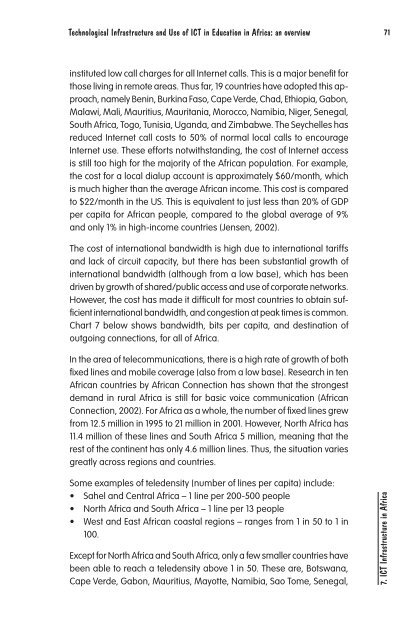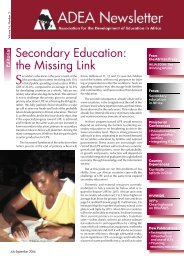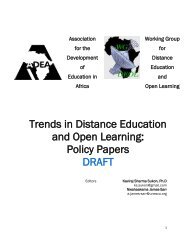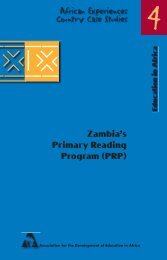Technological Infrastructure and Use of ICT in Education in ... - ADEA
Technological Infrastructure and Use of ICT in Education in ... - ADEA
Technological Infrastructure and Use of ICT in Education in ... - ADEA
You also want an ePaper? Increase the reach of your titles
YUMPU automatically turns print PDFs into web optimized ePapers that Google loves.
<strong>Technological</strong> <strong>Infrastructure</strong> <strong>and</strong> <strong>Use</strong> <strong>of</strong> <strong>ICT</strong> <strong>in</strong> <strong>Education</strong> <strong>in</strong> Africa: an overview<br />
71<br />
<strong>in</strong>stituted low call charges for all Internet calls. This is a major benefit for<br />
those liv<strong>in</strong>g <strong>in</strong> remote areas. Thus far, 19 countries have adopted this approach,<br />
namely Ben<strong>in</strong>, Burk<strong>in</strong>a Faso, Cape Verde, Chad, Ethiopia, Gabon,<br />
Malawi, Mali, Mauritius, Mauritania, Morocco, Namibia, Niger, Senegal,<br />
South Africa, Togo, Tunisia, Ug<strong>and</strong>a, <strong>and</strong> Zimbabwe. The Seychelles has<br />
reduced Internet call costs to 50% <strong>of</strong> normal local calls to encourage<br />
Internet use. These efforts notwithst<strong>and</strong><strong>in</strong>g, the cost <strong>of</strong> Internet access<br />
is still too high for the majority <strong>of</strong> the African population. For example,<br />
the cost for a local dialup account is approximately $60/month, which<br />
is much higher than the average African <strong>in</strong>come. This cost is compared<br />
to $22/month <strong>in</strong> the US. This is equivalent to just less than 20% <strong>of</strong> GDP<br />
per capita for African people, compared to the global average <strong>of</strong> 9%<br />
<strong>and</strong> only 1% <strong>in</strong> high-<strong>in</strong>come countries (Jensen, 2002).<br />
The cost <strong>of</strong> <strong>in</strong>ternational b<strong>and</strong>width is high due to <strong>in</strong>ternational tariffs<br />
<strong>and</strong> lack <strong>of</strong> circuit capacity, but there has been substantial growth <strong>of</strong><br />
<strong>in</strong>ternational b<strong>and</strong>width (although from a low base), which has been<br />
driven by growth <strong>of</strong> shared/public access <strong>and</strong> use <strong>of</strong> corporate networks.<br />
However, the cost has made it difficult for most countries to obta<strong>in</strong> sufficient<br />
<strong>in</strong>ternational b<strong>and</strong>width, <strong>and</strong> congestion at peak times is common.<br />
Chart 7 below shows b<strong>and</strong>width, bits per capita, <strong>and</strong> dest<strong>in</strong>ation <strong>of</strong><br />
outgo<strong>in</strong>g connections, for all <strong>of</strong> Africa.<br />
In the area <strong>of</strong> telecommunications, there is a high rate <strong>of</strong> growth <strong>of</strong> both<br />
fixed l<strong>in</strong>es <strong>and</strong> mobile coverage (also from a low base). Research <strong>in</strong> ten<br />
African countries by African Connection has shown that the strongest<br />
dem<strong>and</strong> <strong>in</strong> rural Africa is still for basic voice communication (African<br />
Connection, 2002). For Africa as a whole, the number <strong>of</strong> fixed l<strong>in</strong>es grew<br />
from 12.5 million <strong>in</strong> 1995 to 21 million <strong>in</strong> 2001. However, North Africa has<br />
11.4 million <strong>of</strong> these l<strong>in</strong>es <strong>and</strong> South Africa 5 million, mean<strong>in</strong>g that the<br />
rest <strong>of</strong> the cont<strong>in</strong>ent has only 4.6 million l<strong>in</strong>es. Thus, the situation varies<br />
greatly across regions <strong>and</strong> countries.<br />
Some examples <strong>of</strong> teledensity (number <strong>of</strong> l<strong>in</strong>es per capita) <strong>in</strong>clude:<br />
• Sahel <strong>and</strong> Central Africa – 1 l<strong>in</strong>e per 200-500 people<br />
• North Africa <strong>and</strong> South Africa – 1 l<strong>in</strong>e per 13 people<br />
• West <strong>and</strong> East African coastal regions – ranges from 1 <strong>in</strong> 50 to 1 <strong>in</strong><br />
100.<br />
Except for North Africa <strong>and</strong> South Africa, only a few smaller countries have<br />
been able to reach a teledensity above 1 <strong>in</strong> 50. These are, Botswana,<br />
Cape Verde, Gabon, Mauritius, Mayotte, Namibia, Sao Tome, Senegal,<br />
7. <strong>ICT</strong> <strong>Infrastructure</strong> <strong>in</strong> Africa

















